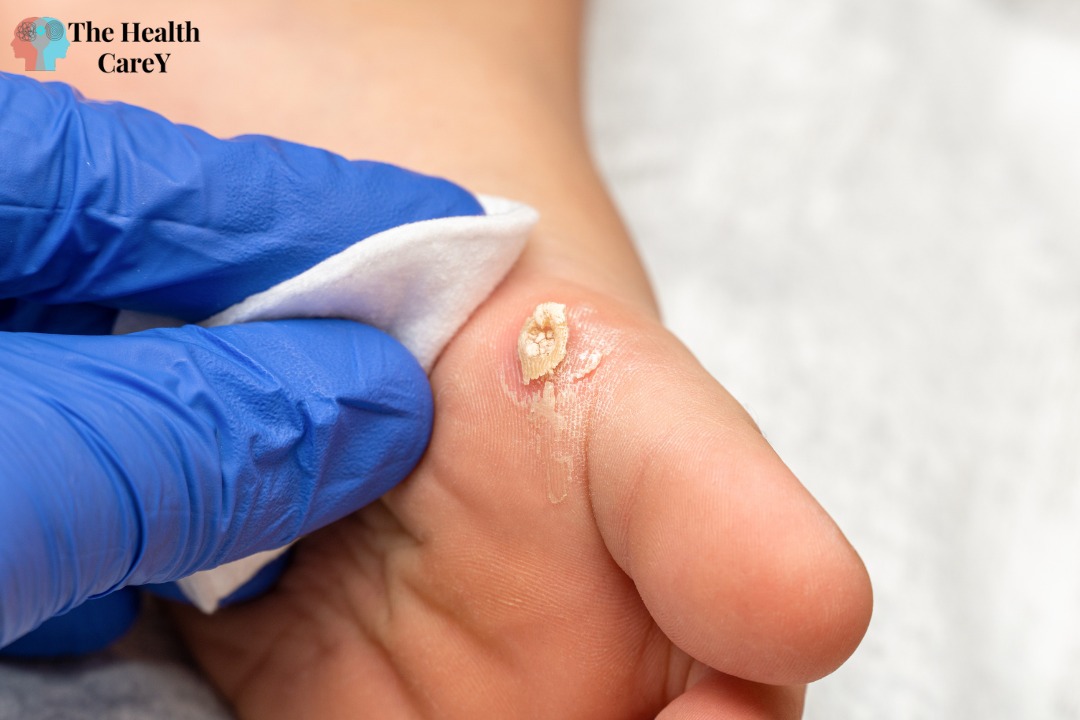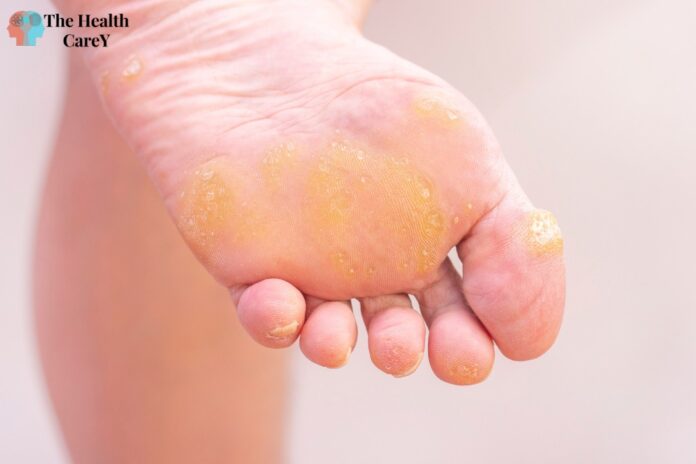Seed corn on foot is a common foot condition that can cause significant discomfort and pain. Seed corns are small, hard, and circular lesions that usually appear on the bottom of your foot. They are usually caused by excessive pressure or friction on the foot, which can be due to a variety of factors such as ill-fitting shoes, walking barefoot, or standing for long periods.
If you have seed corn on the bottom of your foot, you may experience symptoms such as pain, tenderness, and discomfort when walking or standing. The good news is that seed corns are treatable, and there are several ways to get rid of them. In this article, we will discuss what seed corn on foot is, its causes, symptoms, and how to treat and prevent it.
Key Takeaways
- Seed corn on foot is a common foot condition that can cause pain and discomfort.
- Seed corns are small, hard, and circular lesions that usually appear on the bottom of your foot due to excessive pressure or friction.
- Seed corns can be treated and prevented by taking care of your feet, wearing comfortable shoes, and using home remedies or medical treatments.
What is a Seed Corn on Foot?
A seed corn on foot is a small, hard, and painful lesion that develops on the sole of your foot. It is a type of callus that is caused by the pressure and friction of your foot against your shoes or the ground. Seed corns on foot are usually found on weight-bearing areas of the foot, such as the ball or heel.
Seed corns on foot are often mistaken for warts or corns, but they are different. Warts are caused by a viral infection, while corns are caused by pressure and friction. Seed corns on foot are more like corns, but they are smaller and have a hard, central core.
If you have a seed corn on foot, you may experience pain or discomfort when walking or standing. The pain can range from mild to severe, depending on the size and location of the seed corn. You may also notice that the skin around the seed corn is thick and yellowish.
To treat a seed corn on foot, you can try to remove the hard, central core with a pumice stone or emery board. You can also use over-the-counter corn pads or cushions to relieve pressure and reduce pain. If the seed corn is large or causing severe pain, you may need to see a podiatrist for professional treatment.
In conclusion, a seed corn on foot is a small, hard, and painful lesion that develops on the sole of your foot due to pressure and friction. It is important to properly identify and treat seed corns on foot to prevent further pain and discomfort.
Seed Corn on Bottom of Foot
If you have ever experienced a painful spot on the bottom of your foot that feels like a small pebble, you may have seed corns. Seed corns are small, hard, and circular lesions that can develop on the bottom of your foot. These corns can be caused by pressure or friction on the skin, and they can be painful when you stand or walk.
Seed corns are typically small, about the size of a pinhead, but they can sometimes grow larger. They are often found on the ball of the foot or the heel, but they can also appear on the toes. Seed corns can be caused by wearing shoes that are too tight or too loose, or by walking barefoot on hard surfaces.
If you have seed corns on the bottom of your foot, there are a few things you can do to relieve the pain and discomfort. You can try soaking your feet in warm water and then using a pumice stone to gently remove the dead skin around the corn. You can also use over-the-counter corn pads or cushions to protect the corn from further pressure.
If these home remedies do not work, you may need to see a podiatrist. A podiatrist can remove the seed corns using a variety of methods, such as freezing them with liquid nitrogen or using a laser to remove them.
In conclusion, seed corns on the bottom of your foot can be painful and uncomfortable, but there are ways to treat them. If you have seed corns, try soaking your feet and using over-the-counter remedies. If these do not work, see a podiatrist for further treatment.
Causes of Seed Corn on Foot
Seed corn on foot is a common condition that causes small, hard, and painful areas on the soles of your feet. Here are some of the most common causes of seed corn on foot:
Friction and Pressure
Seed corns can develop due to excessive friction and pressure on your feet. This can be caused by wearing tight or ill-fitting shoes, high heels, or shoes without proper support. When your feet are subjected to constant pressure and friction, the skin thickens and can form seed corns.
Inappropriate Footwear
Wearing inappropriate footwear is another common cause of seed corns. Shoes that are too tight, too loose, or do not provide enough support can cause your feet to be subjected to pressure and friction, leading to seed corns. Additionally, shoes with hard soles or high heels can also contribute to the development of seed corns.
Foot Deformities
Certain foot deformities, such as hammertoes or bunions, can also cause seed corns to develop. These conditions cause abnormal pressure and friction on specific areas of your feet, leading to the formation of seed corns.
In summary, seed corn on foot is caused by excessive pressure and friction on your feet, inappropriate footwear, and foot deformities. By understanding these causes, you can take steps to prevent the development of seed corns and keep your feet healthy.
Symptoms of Seed Corn on Foot
If you have seed corn on your foot, you may experience a variety of symptoms. Here are some of the most common ones:
Hard Skin Formation
One of the first signs of seed corn on foot is the formation of hard skin on the bottom of your foot. This hard skin can be painful and uncomfortable, especially when you are walking or standing for long periods of time. You may also notice that the skin is thicker than usual and has a yellowish or grayish color.
Pain and Discomfort
As the seed corn grows, you may start to experience pain and discomfort in your foot. This pain can be sharp or dull and may be worse when you put pressure on the affected area. You may also notice that the pain is worse in the morning or after you have been standing or walking for a long time.
Foot Appearance Changes
As the seed corn continues to grow, you may notice changes in the appearance of your foot. The affected area may become red and inflamed, and you may notice small black dots in the center of the seed corn. These dots are actually tiny blood vessels that have been pushed to the surface of the skin.
If you are experiencing any of these symptoms, it is important to seek treatment as soon as possible. Ignoring seed corn on foot can lead to more serious complications, such as infections or the development of other foot problems.

How to Treat a Seed Corn on Foot
If you have a seed corn on your foot, you may be wondering how to treat it. Fortunately, there are several options available to you. In this section, we’ll cover both home remedies and medical treatments.
Home Remedies
Home remedies can be a great option for treating seed corns on your feet. Here are a few things you can try:
- Soak your feet in warm water for 10-15 minutes to soften the skin.
- Use a pumice stone to gently exfoliate the area around the seed corn.
- Apply a moisturizing cream to the affected area to help soften the skin.
- Use a cushioned insole or padding to relieve pressure on the seed corn.
Medical Treatments
If home remedies aren’t working for you, you may need to seek medical treatment. Here are a few options:
- Over-the-counter creams or ointments that contain salicylic acid can help dissolve the seed corn.
- Your doctor may recommend debridement, which involves removing the dead skin around the seed corn.
- If the seed corn is causing significant pain, your doctor may recommend a corticosteroid injection to reduce inflammation.
Remember, if you have a seed corn on your foot, it’s important to take action to treat it. With the right treatment, you can get relief from pain and discomfort.
Prevention of Seed Corn on Foot
Seed corns on your foot can be prevented with proper care and attention. Here are some steps you can take to prevent them from forming:
Proper Footwear
Wearing the right footwear is crucial in preventing seed corns on your foot. Choose shoes that fit well and have enough room for your toes to move. Avoid wearing shoes that are too tight or too loose, as they can cause friction and pressure on your feet.
Additionally, consider wearing cushioned insoles or inserts to provide extra support and comfort to your feet. This can help reduce the risk of developing seed corns.
Regular Foot Care
Maintaining proper foot care is also important in preventing seed corns on your foot. Here are some tips to keep your feet healthy:
- Wash your feet daily with soap and warm water.
- Dry your feet thoroughly, especially between your toes.
- Moisturize your feet with lotion to prevent dryness and cracking.
- Trim your toenails regularly to prevent ingrown toenails.
- Check your feet regularly for any signs of redness, swelling, or blisters.
By following these steps, you can reduce your risk of developing seed corns on your foot. Remember to always wear proper footwear and take care of your feet to keep them healthy and pain-free.
Possible Complications of Seed Corn on Foot
Seed corn on foot is a common condition that can cause discomfort and pain. While it is usually harmless, it can sometimes lead to complications. Here are some possible complications of seed corn on foot:
Infection
If the seed corn on your foot becomes infected, it can cause redness, swelling, and pain. In severe cases, the infection can spread and lead to cellulitis or even sepsis. To prevent infection, it is important to keep your feet clean and dry, avoid walking barefoot in public places, and seek medical attention if you notice any signs of infection.
Ulceration
Seed corn on foot can sometimes cause ulceration, which is a break in the skin that can lead to infection. Ulceration can occur if the seed corn is left untreated or if it is repeatedly irritated or rubbed against footwear. To prevent ulceration, it is important to wear comfortable and well-fitting shoes, avoid high heels, and seek medical attention if you notice any signs of ulceration.
Chronic Pain
In some cases, seed corn on foot can cause chronic pain that can affect your quality of life. Chronic pain can occur if the seed corn is left untreated or if it is repeatedly irritated or rubbed against footwear. To manage chronic pain, it is important to wear comfortable and well-fitting shoes, avoid high heels, and seek medical attention if you have persistent pain.
Conclusion
Seed corn on foot is a common condition that can cause discomfort and pain. While it is usually harmless, it can sometimes lead to complications. If you have seed corn on your foot, it is important to take steps to prevent complications and seek medical attention if you notice any signs of infection, ulceration, or chronic pain.
Frequently Asked Questions
What causes seed corns to form on the foot?
Seed corns, also known as porokeratosis, are caused by a buildup of dead skin cells on the surface of the skin. This can be due to a variety of factors, including wearing shoes that don’t fit properly, walking barefoot on hard surfaces, or excessive sweating.
What are some effective methods for removing seed corns on the foot?
There are several effective methods for removing seed corns, including using a pumice stone or foot file to gently exfoliate the affected area, applying a salicylic acid solution to dissolve the dead skin cells, or seeing a podiatrist for professional treatment.
Is it safe to remove a seed corn on your own?
While it is possible to remove a seed corn on your own, it is important to do so safely and carefully to avoid further damage to the skin. If you are unsure about how to remove a seed corn, it is best to seek professional treatment from a podiatrist.
How long does it take for a seed corn on the foot to go away?
The length of time it takes for a seed corn to go away can vary depending on the severity of the condition and the treatment method used. In some cases, a seed corn may go away on its own within a few weeks, while in other cases it may require professional treatment.
Can wearing certain types of shoes prevent seed corns on the foot?
Wearing shoes that fit properly and provide adequate support can help prevent seed corns from forming on the foot. It is also important to avoid walking barefoot on hard surfaces and to keep the feet clean and dry.
Are there any home remedies for treating seed corns on the foot?
There are several home remedies that may be effective for treating seed corns, including soaking the feet in warm water and Epsom salt, applying aloe vera gel or coconut oil to the affected area, or using a combination of apple cider vinegar and baking soda to exfoliate the skin. However, it is important to use caution when trying these remedies and to seek professional treatment if the condition persists or worsens.
Also Read:
Does Kombucha Help with Bloating?
Types of Injection to Dissolve Bone Spurs




















